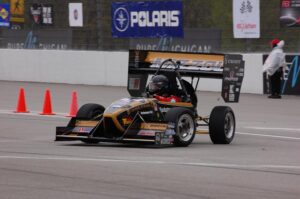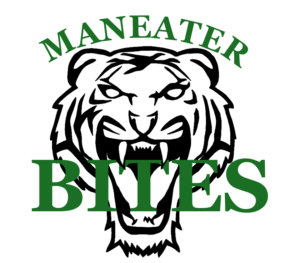July 8, 2014
During the school year, the 20 students on the MU Formula SAE team work up to 40 hours a week — their task is to design and build a vehicle that would make any race car enthusiast proud.
Operating out of Room 131 in Engineering Building West, the team prepares for the summer competition season, applying skills learned from engineering classes and hands-on experiences.
Once they complete their car, the team races in Detroit, Michigan and Lincoln, Nebraska during the summer months. The competitions are linked to the national professional car design organization, SAE International (formerly known as Society of Automotive Engineers).
This year, their efforts paid off. The Formula SAE team placed 19th in Detroit, advancing them to the competition in Lincoln, where they placed 13th.
“At Michigan there are 100 to 120 universities, and in Nebraska there are 80 to 90 teams,” team member and senior Rory Hourihan said. “There’s about 450 universities that do this worldwide.”
The worldwide network has competitions in locations such as China and Germany, where outrageous designs are prominent. But when the MU SAE team prepares to compete domestically each year, it needs to ensure its efforts reflect a more modest, consumer-friendly design.
“We try to design as much as we can before we start building,” Hourihan said. “That will take maybe three months or so, and the rest of the six months are spent building and wrapping up smaller designs.”
The majority of the team are mechanical or electrical engineering students, although the 2014 – 2015 Formula SAE president and senior Lauren Wertz is an industrial engineer.
But being an engineer isn’t a requirement, Wertz said.
“You don’t just need engineers,” she said. “You need people who are hands on-and willing to work hard and willing to learn. I’d like to think our group is a small business — you’re managing your own money, time and you have a target market we’re supposed to design toward.”
Regardless of who’s dealing with machinery and parts or who’s working with wiring and data input and acquisition, everything is done by the team’s own strength.
When the team members meet each week, they split up to plan out different departments — teams in of themselves — for each part of the car: aerodynamics, suspension, powertrain, drivetrain, chassis, cockpit, safety and controls, and electronics and data acquisition.
The team uses SolidWorks, a 3-D modeling design program, to draw the car out and analyze how a potential structure could hold up.
The design is built off of concepts acquired from classes. But the team also builds off the successes and failures of previous designs, Wertz said.
When the cars are tested in “dynamic” events, teams race their vehicles around tracks, testing aspects such as the acceleration and endurance of the vehicles.
If the Formula SAE team observes any issues, such as possible overheating or a need to drop weight off the car, they will take them into account for the following year.
“We work every year based off our old design and trying to improve it,” Wertz said. “Usually we’ll make a goal at the beginning of the year: What are the main things we would like to improve?”
2013 – 2014 Formula SAE president and recent graduate Jacob Brown said that last year the team competed with a car that was built based off little experience.
After the team assessed needs of simplicity and changes in aerodynamics and made changes accordingly, the newly designed car was more successful.
“In 2014 we ended up with a car that was much cleaner than the year before,” Brown said. “We used many interchangeable parts throughout the vehicle to speed up manufacturing time and reduce the number of different parts on the car. Once we redesigned the overall package, or as I like to call it, the base, bare bones, or foundation, we were able to focus on details of sub systems.”
The team doesn’t just need to go off of observations from previous years. It also has feedback and advice from people at the competitions.
At the competition, engineers from the actual automotive industry question the teams on the designs of their cars during “static” events, giving feedback that goes into making the car more cost-efficient, or ultimately more efficient overall.
Additional lessons learned from other teams also help, Wertz said.
“The great thing about competition is you have 120 teams who all have a common goal through what we’ve been working on all year,” she said. “It’s a great collaborative thing to talk to all of these teams and see what about their cars is cool or cutting edge, (if it’s) something we should look into… and see if we can add it to our car. It’s a once in a lifetime experience to collaborate with this many students from around the world who share the same interests.”



Comments
The Maneater has the right to remove comments that do not comply with policies surrounding hate speech.